In today’s
Insider:
***The Consumer is the Key
***Gold is Okay
***A Credit Crunch a Comin'
Dear Reader,
Investors convinced that the recent spate of good economic news will cause the Federal reserve to raise interest rates before the end of the year. They're dead wrong. But that's okay…it's a great opportunity for you to buy gold and precious metals at a discount, and make some short term profits in a few sectors.
Here's the fact investor are missing: consumers can't afford rising interest rates. Need proof? Away we go….
First, rewind back to the consumer credit figures from February. Consumer credit was up $4.2 billion from January. But in January, consumer debt had rise by $15.8 billion from December's level. What's going on here? Easy. Interest rates have been creeping up, and are already hurting consumers at the margin, especially on their credit card debt.
The February increase was the smallest increase in consumer debt in five months.
Rising interest rates are causin consumers to cut back on their use of credit. Of course, that appears to be contradicted by the retail sales report right? Not so fast…
True, March retail sales showed the biggest gain in a year—up 8.2% from the same time last year. But here are three striking details.
First, department store sales actually fell from February to March by 0.8%. Second, sales of sporting goods, books, and music FELL 0.7% from February to March. And third, sales of building materials grew by 10.8%, the largest gain of any category.
Notice a pattern here?
This is the kind of behavior you'd expect from a consumer who expects interest rates to rise. He locks in housing related purchases before rates move up from historic lows. And he cuts back on purchases at the margin…the little things that start to make a difference once more of your income goes to servicing your debts.
In other words,
as rates rise, the consumer starts consuming less.
Absent a huge increase in income, rising rates are deflationary to consumer spending.
For example, take the most rate sensitive of purchases, your house.
The Mortgage Bankers Association said today its refinancing index tumbled 30.7% last week. That was the biggest one week drop since late July, to 2,861.6 from the previous week's 4,126.7. The purchase index, which gauges new loan requests, fell by 9.5%. What's more, the group's weekly mortgage gauge fell for the fourth week in a row to its lowest level since the week of Jan. 9.
Even if you excluded the effect of rising rates on borrowers with adjustable rate mortgages,
the whole effect of rising interest rates is put a chill on consumer spending. When 70% of GDP comes from consumer spending, the Fed had better be darn sure the recover is on solid ground before it starts raising rates.
But if you listen to the Fed, it's not sure at all. Far from it. In fact, I'd say it's downright skeptical. At a luncheon in St. Louis last week (this from my man on the case Greg Weldon)
Fed inflation hawk William Poole said,“
"We do not want to respond to inflation noise, which would add further instability to the economy. We cannot reliably conclude that today's material price inflation will be tomorrow's finished goods inflation."
Poole also said,
"It is going to take some string of months, but I cannot really put a time frame on it." Referring to inflationary PPI numbers, Boston Fed Research Director said last week,
"We need a good many months like this." And Dallas Fed Research Director Harvey Rosenblum said,
"There is room for further disappointment between this number, and the end of June."
Does this sound like a central bank that's planning to raise rates to you?
It doesn't to me. And even today's consumer price inflation numbers wouldn't bother me much. Consumer prices were up 0.5%. To the market, this suggests that inflation is finally showing up in finished goods. And indeed, that may be true.
But
the Fed's response to this CANNOT be to raise rates until the final piece of the inflation puzzle is in place: rising consumer incomes. Until that happens, rising prices will simply make consumers cut back on spending. Throw in rising interest rates and energy prices and you have two more factors which lead to slower consumer spending and economic growth.
Bottom line: the economy can't grow until the consumer can spend more. And the consumer can't spend more when prices and interest rates are rising. If consumer incomes don't inflate, inflation in producer prices or consumer prices won't matter. Until consumer incomes rise, the Fed stands pat.
And here's a prediction for you, the Fed will become so concerned with the market pricing in rising rates (and pushing mortgage rates up) that it will cut rates by 25 basis points at its May 4th or June 30th meeting.
That's not to say that the Fed will be effective in stopping the sell-off in bonds and in interest rate sensitive stocks (REITS, for example). But it is to say the Fed still considers deflation its sworn enemy. And until consumers incomes pick up, rising rates are likely to lead to much lower consumer borrowing and spending…which, in the last fifty years, has been very bad for American GDP.
It's pretty simple, consumer prices won't rise much if consumers don't have money to spend.
***Gold is Okay
I'm going to keep the gold section short because I don't have much to ad and nothing has changed in the last three days to make me alter my bullishness. Yes, gold is getting whacked. But so is everything else. As I said in the weekly edition, the reflation trade is ending…in deflating asset prices.
Gold stocks are stocks. And like everything else that's risen on a sea of liquidity, gold stocks are falling as interest rates rise and the credit crunch begins. However if you look at the five-year weekly charts for the XAU and HUI, you’ll see that both hedged and unhedged gold stocks are trading right at their 40-week moving averages. They have not broken down technically.

It's possible, of course, that they'll break through those moving averages and trade below them. But I would simply consider that an opportunity to buy more of your favorite gold stocks at a cheaper price.
If I'm right about the Fed being deathly afraid of deflation, you'll start to see the Fed become more active in getting money into consumer pockets. This includes expanding the money supply, as I noted yesterday. This is bullion bullish.
True, the market may push the dollar up, and gold down as a consequence, while it sorts out the effect of rising rates. But there's a big difference between falling gold prices and falling bond and stock prices right now.
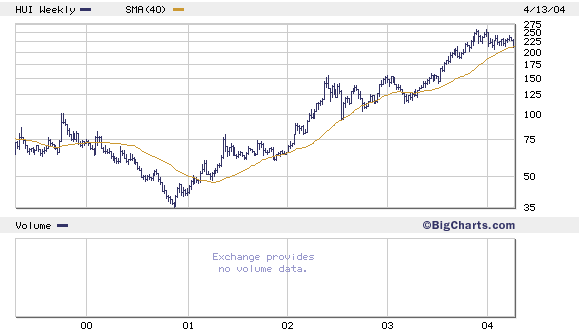
Bond prices are falling because bonds have been in a 20-year bull market that's ending---especially as we head towards more inflation in raw materials.
Stock prices are falling because the only thing supporting them was money that could be borrowed cheaply and funneled into the market for yield and instant return. Now that money is getting more expensive, stocks are losing the biggest source of their upward momentum.
Gold, on the other hand, is rising because commodities have been in a 20-year bear market. It's rising because the central banks of the world find themselves in a monetary no-man's land where no solution is a good solution, and doing nothing is even worse. All gold has to do is sit around and watch the bankers fail one at a time.
Don't be surprised if it falls more. As I said, gold stocks are still stocks. And as stocks sell off in financial asset disinflation, gold stocks won't be unaffected. But fundamentally, gold stocks are backed by a real asset. And for that reason, they're a buy.
***A Credit Crunch a Comin’
What's a credit crunch? A liquidity trap? It's when banks get wary of loaning and borrowers get wary of borrowing. It's what happens when money has been too cheap for too long. Why do both parties get wary? Both get burned by higher rates and rising delinquencies and non-performing loans.
This is the beginning of the great deflation in financial assets I wrote about in April. It's a giant write-down in the value of assets that rose purely as a function of money cheaply borrowed. Debt deflation.
In the long-term, this means stocks, bonds, and houses have the most downside. In the short-term, it will mean everything that reflated in the last twelve months suffers some set backs. As in investor in gold, be prepared. But don't be scared out of what is fundamentally as sound an investment s you can make.
What we need to figure out next, and what I'll tackle tomorrow, is what the Fed does to create inflation when it's monetary gun is out of bullets. So far, it's managed to cause a housing bubble, a stock market bubble, and some "flash bubbles" in commodities.
But
its single greatest failure is also the one that will cause it to try even more desperate measures: it's failed to inflate consumer incomes.
If it looked to Japan, it would see that once the consumer has set is mind against expanding his spending, there's not a lot a central bank can do to change it. That won’t keep the Fed from trying though. More on that tomorrow.
Best Regards Until Then,
Dan
 Short Term Bearishness on the OEX Picking Up Pace
Short Term Bearishness on the OEX Picking Up Pace
 The 50-day moving average in the OEX bullish percentage chart is
threatening to cross the 100-day moving average. It's a bearish sign
that could signal a sell off in the OEX and OEF, the exchange traded
fund that tracks OEX.
When Moving Averages Cross, Buy Puts on OEF
The 50-day moving average in the OEX bullish percentage chart is
threatening to cross the 100-day moving average. It's a bearish sign
that could signal a sell off in the OEX and OEF, the exchange traded
fund that tracks OEX.
When Moving Averages Cross, Buy Puts on OEF
 Two of the three times the short-term moving average crosses under the
longer-term moving average, OEF has sold off by an average of thirty percent.
Two of the three times the short-term moving average crosses under the
longer-term moving average, OEF has sold off by an average of thirty percent.

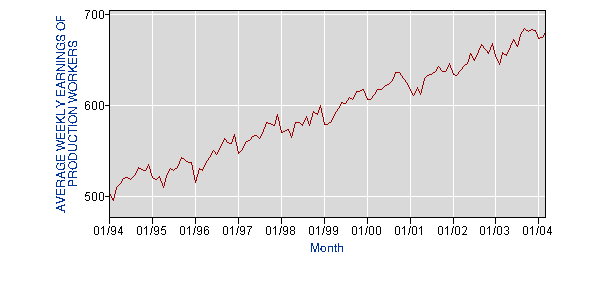 During the same period, average weekly earnings in retail trade jobs grew 38%, from $265/week in 1994 to $367/week in 2004. Even though wages here grew at a full percentage point per year faster than goods producing jobs, the average weekly income in retail jobs is still 82% below the average weekly income in a goods producing job.
During the same period, average weekly earnings in retail trade jobs grew 38%, from $265/week in 1994 to $367/week in 2004. Even though wages here grew at a full percentage point per year faster than goods producing jobs, the average weekly income in retail jobs is still 82% below the average weekly income in a goods producing job.
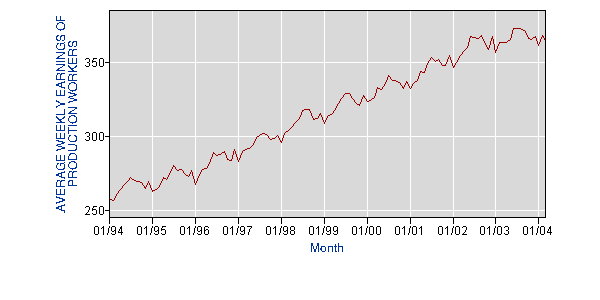 And by the way, for all non-farm jobs combined, average weekly earnings grew from $390 in 1994 to $517 in 2004-a 32% increase over ten years, or 3.2% a year.
And by the way, for all non-farm jobs combined, average weekly earnings grew from $390 in 1994 to $517 in 2004-a 32% increase over ten years, or 3.2% a year.
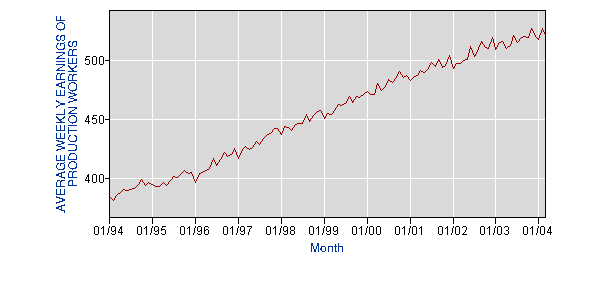 The point of all this? Ten years does not a long-term trend make. But wage growth in America sucks. Ask about anyone you know. You'll get the same sentiment
There are lots of roots to this thorny problem. It's not just China and India. It's higher productivity requiring fewer workers.
For example, I was able to cobble together all the data for the above analysis in about two hours. Five years ago, it would have taken me two days, if not more, and required at least two people...to find the data, put in a spreadsheet, create a graph, give it to a graphic designer etc etc.
Today, it's just me. And you suspect that as technology becomes more pervasive, it makes employees less valuable-most employees that is.
Some end up being much MORE valuable. They're the ones who get the wage increases. And they're the ones Greenspan would like all Americans to become like.
The problem is, there are a lot of displaced employees who will have to retrain to be productive in this manufacturing lite, service heavy economy, if they want to make a fat wage that is.
I'm not a class agitator. But I get the distinct picture there will be fewer high-paying jobs in America in the future, although they'll pay very very well. On the other hand, there will be a lot of jobs that pay about $11.90 per hour and about $500 per week. That's a tough way to make a living.
Tomorrow, a look at which sectors to focus your options energy on to make money off this stagnation in wage growth. And also, more progress on the question of the hour...what does the Fed do next?
Until Then,
Dan
The point of all this? Ten years does not a long-term trend make. But wage growth in America sucks. Ask about anyone you know. You'll get the same sentiment
There are lots of roots to this thorny problem. It's not just China and India. It's higher productivity requiring fewer workers.
For example, I was able to cobble together all the data for the above analysis in about two hours. Five years ago, it would have taken me two days, if not more, and required at least two people...to find the data, put in a spreadsheet, create a graph, give it to a graphic designer etc etc.
Today, it's just me. And you suspect that as technology becomes more pervasive, it makes employees less valuable-most employees that is.
Some end up being much MORE valuable. They're the ones who get the wage increases. And they're the ones Greenspan would like all Americans to become like.
The problem is, there are a lot of displaced employees who will have to retrain to be productive in this manufacturing lite, service heavy economy, if they want to make a fat wage that is.
I'm not a class agitator. But I get the distinct picture there will be fewer high-paying jobs in America in the future, although they'll pay very very well. On the other hand, there will be a lot of jobs that pay about $11.90 per hour and about $500 per week. That's a tough way to make a living.
Tomorrow, a look at which sectors to focus your options energy on to make money off this stagnation in wage growth. And also, more progress on the question of the hour...what does the Fed do next?
Until Then,
Dan
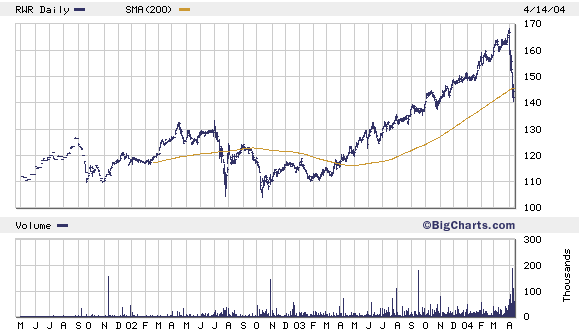
 It's possible, of course, that they'll break through those moving averages and trade below them. But I would simply consider that an opportunity to buy more of your favorite gold stocks at a cheaper price.
If I'm right about the Fed being deathly afraid of deflation, you'll start to see the Fed become more active in getting money into consumer pockets. This includes expanding the money supply, as I noted yesterday. This is bullion bullish.
True, the market may push the dollar up, and gold down as a consequence, while it sorts out the effect of rising rates. But there's a big difference between falling gold prices and falling bond and stock prices right now.
It's possible, of course, that they'll break through those moving averages and trade below them. But I would simply consider that an opportunity to buy more of your favorite gold stocks at a cheaper price.
If I'm right about the Fed being deathly afraid of deflation, you'll start to see the Fed become more active in getting money into consumer pockets. This includes expanding the money supply, as I noted yesterday. This is bullion bullish.
True, the market may push the dollar up, and gold down as a consequence, while it sorts out the effect of rising rates. But there's a big difference between falling gold prices and falling bond and stock prices right now.
 Bond prices are falling because bonds have been in a 20-year bull market that's ending---especially as we head towards more inflation in raw materials. Stock prices are falling because the only thing supporting them was money that could be borrowed cheaply and funneled into the market for yield and instant return. Now that money is getting more expensive, stocks are losing the biggest source of their upward momentum.
Gold, on the other hand, is rising because commodities have been in a 20-year bear market. It's rising because the central banks of the world find themselves in a monetary no-man's land where no solution is a good solution, and doing nothing is even worse. All gold has to do is sit around and watch the bankers fail one at a time.
Don't be surprised if it falls more. As I said, gold stocks are still stocks. And as stocks sell off in financial asset disinflation, gold stocks won't be unaffected. But fundamentally, gold stocks are backed by a real asset. And for that reason, they're a buy.
***A Credit Crunch a Comin’
What's a credit crunch? A liquidity trap? It's when banks get wary of loaning and borrowers get wary of borrowing. It's what happens when money has been too cheap for too long. Why do both parties get wary? Both get burned by higher rates and rising delinquencies and non-performing loans.
This is the beginning of the great deflation in financial assets I wrote about in April. It's a giant write-down in the value of assets that rose purely as a function of money cheaply borrowed. Debt deflation.
In the long-term, this means stocks, bonds, and houses have the most downside. In the short-term, it will mean everything that reflated in the last twelve months suffers some set backs. As in investor in gold, be prepared. But don't be scared out of what is fundamentally as sound an investment s you can make.
What we need to figure out next, and what I'll tackle tomorrow, is what the Fed does to create inflation when it's monetary gun is out of bullets. So far, it's managed to cause a housing bubble, a stock market bubble, and some "flash bubbles" in commodities.
But its single greatest failure is also the one that will cause it to try even more desperate measures: it's failed to inflate consumer incomes.
If it looked to Japan, it would see that once the consumer has set is mind against expanding his spending, there's not a lot a central bank can do to change it. That won’t keep the Fed from trying though. More on that tomorrow.
Best Regards Until Then,
Dan
Bond prices are falling because bonds have been in a 20-year bull market that's ending---especially as we head towards more inflation in raw materials. Stock prices are falling because the only thing supporting them was money that could be borrowed cheaply and funneled into the market for yield and instant return. Now that money is getting more expensive, stocks are losing the biggest source of their upward momentum.
Gold, on the other hand, is rising because commodities have been in a 20-year bear market. It's rising because the central banks of the world find themselves in a monetary no-man's land where no solution is a good solution, and doing nothing is even worse. All gold has to do is sit around and watch the bankers fail one at a time.
Don't be surprised if it falls more. As I said, gold stocks are still stocks. And as stocks sell off in financial asset disinflation, gold stocks won't be unaffected. But fundamentally, gold stocks are backed by a real asset. And for that reason, they're a buy.
***A Credit Crunch a Comin’
What's a credit crunch? A liquidity trap? It's when banks get wary of loaning and borrowers get wary of borrowing. It's what happens when money has been too cheap for too long. Why do both parties get wary? Both get burned by higher rates and rising delinquencies and non-performing loans.
This is the beginning of the great deflation in financial assets I wrote about in April. It's a giant write-down in the value of assets that rose purely as a function of money cheaply borrowed. Debt deflation.
In the long-term, this means stocks, bonds, and houses have the most downside. In the short-term, it will mean everything that reflated in the last twelve months suffers some set backs. As in investor in gold, be prepared. But don't be scared out of what is fundamentally as sound an investment s you can make.
What we need to figure out next, and what I'll tackle tomorrow, is what the Fed does to create inflation when it's monetary gun is out of bullets. So far, it's managed to cause a housing bubble, a stock market bubble, and some "flash bubbles" in commodities.
But its single greatest failure is also the one that will cause it to try even more desperate measures: it's failed to inflate consumer incomes.
If it looked to Japan, it would see that once the consumer has set is mind against expanding his spending, there's not a lot a central bank can do to change it. That won’t keep the Fed from trying though. More on that tomorrow.
Best Regards Until Then,
Dan

